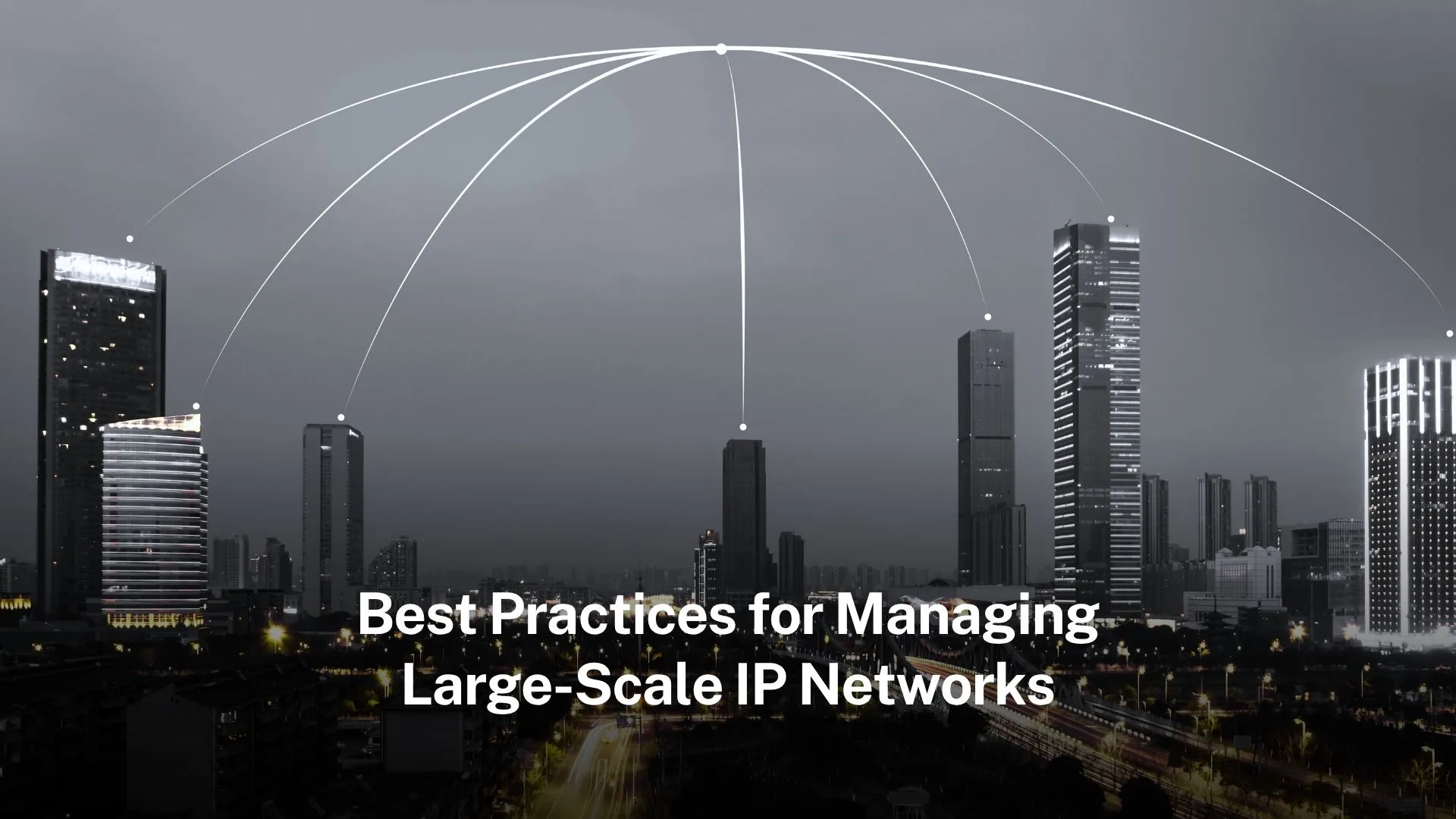Managing large-scale IP networks ensures reliability. It guarantees performance. It supports scalability. All these matter in today’s interconnected world.
Table of Contents
ToggleDemand is growing. High-bandwidth applications are driving this demand. Managing large-scale IP networks needs robust strategies. It also requires powerful tools.
Several key points need consideration. Network automation is one. Security is another. Traffic management is essential. Effective monitoring is also a must.
Businesses and industries rely on the internet more each day. They use it for everyday operations.
Large-scale networks have unique challenges. They span multiple geographic regions. They serve millions of users. Network administrators face big tasks. They must keep the network stable. They need to ensure security. They have to make it scalable. All this is to meet growing demands.
This article explores best practices. These practices are for managing large-scale IP networks. It focuses on strategies. It also looks at tools. These can help organisations. They support optimal performance. They enable scalability. They enhance security.
Managing large-scale IP networks starts with one step. That step is careful planning. Another key step is designing the network architecture. A well-designed network has important qualities. It is scalable. It is flexible. These qualities handle future growth. They also ensure reliability and efficiency. Several key elements need thought.
1.1 Redundancy and High Availability
Redundancy is essential. It prevents downtime. It ensures uninterrupted network service. Organisations can implement redundant pathways. They can also set up backup systems. This reduces the risk of single points of failure. Redundancy has key elements.
Multiple internet connections are important. Organisations can use multiple ISPs. ISPs stand for Internet Service Providers. They can also use multiple network links. A failure in one link won’t disrupt the entire network. This is the benefit.
Failover systems are another element. These systems work automatically. They switch to backup systems. The switch happens when the primary component fails. This ensures continuous operation.
1.2 Scalability
Scalability has a clear meaning. It is the network’s ability to grow. It also refers to handling increased traffic. Building a scalable network needs specific approaches. Organisations should use modular designs. Hierarchical designs are also good. These designs allow easy expansion.
Hierarchical IP address structures are useful. They enable efficient routing. They let the network expand as needed. This is a key advantage.
Virtualisation technologies play a role. These technologies use virtualised network elements. Resources can be added quickly. They can also be reallocated flexibly. This supports network growth.
Networks grow in scale. Managing them manually becomes hard. It’s increasingly impractical. Automation tools are vital. They streamline network operations. They reduce human error. This is a key benefit. Several automation strategies are important.
2.1 Network Automation Tools
Network automation tools have many uses. They manage configuration changes. They handle performance monitoring. They detect faults. They assist with provisioning. These tools ensure smooth operations. Constant manual intervention isn’t needed. Key automation tools exist.
Software-defined networking (SDN) is one tool. SDN lets administrators manage centrally. They can automate network configurations. This optimises traffic routing. It improves network flexibility.
Network function virtualisation (NFV) is another. NFV separates network services from hardware. It creates virtualised network functions. These functions can be scaled easily. They can also be automated.
2.2 Monitoring and Analytics
Proactive network monitoring is valuable. Analytics also play a big role. They help identify potential issues. This happens before performance is affected. Administrators track network traffic continuously. They monitor network health. This allows informed decisions. Problems are addressed promptly. Specific tools support this.
Network monitoring systems (NMS) are essential. These tools offer real-time visibility. They show network performance. They detect issues like congestion. Packet loss and latency are also spotted.
Traffic analysis tools provide insight. They show traffic volume. They identify traffic types. These flow through the network. This helps optimise bandwidth usage. It also enables efficient traffic management.
Large-scale IP networks face challenges. Traffic congestion is a common one. High-volume data applications cause this. Video streaming is an example. Cloud services are another. VoIP also contributes.
3.1 Traffic Prioritisation
Quality of Service (QoS) policies prioritise different traffic types. Importance determines the priority. Real-time communication needs special treatment. VoIP is a good example. It requires low latency. It needs high priority. Large file transfers are different. They can tolerate higher latency. Key techniques manage traffic.
Traffic shaping is one technique. It limits transmission rates. Certain traffic types are targeted. This avoids congestion.
Traffic policing is another method. It enforces traffic flow limits. Excess traffic is handled. It may be discarded. It could also be delayed. This happens when traffic exceeds thresholds.
3.2 Load Balancing
Load balancing has a clear purpose. It distributes traffic evenly. Multiple servers are used. Multiple network paths also help. This prevents overloading single resources. Load balancing solutions offer benefits. They optimise resource utilisation. They reduce latency. They improve network reliability overall.
Security is critical for large-scale IP networks. It’s one of the most important aspects. Data breaches need prevention. Unauthorised access should be stopped. Several key security practices exist.
4.1 Encryption and VPNs
Encryption is fundamental. It secures sensitive data. They establish secure connections. These connections are over the internet. Data remains private. External threats are kept away. VPNs help in specific ways. They safeguard remote access. They ensure secure data transfer across the network.
4.2 Access Control and Authentication
Strict measures are needed. Access controls are important. Authentication mechanisms also matter. They ensure only authorised personnel access resources. Critical network resources are protected. They limit access to sensitive information. Insider threats are reduced.
Large-scale IP networks need regular care. Software updates are also necessary.
5.1 Routine Maintenance
Routine tasks are part of maintenance. Checking hardware components is one. Verifying configurations is another. Testing network links is essential. These tasks identify potential issues. Problems are found before they become critical.
5.2 Software and Firmware Updates
Software updates should be applied. Firmware updates are also needed. Network devices benefit from this. Routers and switches are examples. The latest security patches are installed. Feature enhancements are added. Regular updates offer protection. Vulnerabilities are addressed. Network functionality improves overall.
FAQs
1. What is the role of automation in managing large-scale IP networks?
Automation tools streamline network management. Manual intervention is reduced. Configurations are optimised. Real-time traffic analysis is enabled.
2. How does network monitoring help in managing IP networks?
Network monitoring provides visibility. It shows performance issues in real time. Congestion is one example. Packet loss is another.
3. What is traffic prioritisation, and why is it important?
Traffic prioritisation has a clear definition. It ensures critical applications get priority. VoIP and video conferencing are examples. Less time-sensitive traffic comes later. Network performance improves as a result.
4. Why is security important for large-scale IP networks?
Large-scale IP networks are prime targets. Cyberattacks often focus on them. Robust security measures are needed. They protect against data breaches.
5. How can I improve the scalability of my network?
Modular network designs help. Virtualisation technologies are also useful. Organisations can scale networks this way. Extensive hardware upgrades aren’t needed. Flexibility for future growth is ensured.




